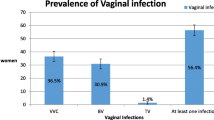Abstract
Objective
The aim of the study was to determine the prevalence and age distribution of Candida albicans and bacterial vaginosis in asymptomatic pregnant women.
Method
One thousand and seventy-three (1,073) consecutive women who attended the antenatal clinic at Barnsley District General Hospital, Barnsley, UK, over a 15-month period were studied. Endo-cervical and high vaginal swabs for Candida albicans were obtained.
Results
Sixty-five percent (65%) were in the age group of 21–30 years, and the smallest group was of age 40 years and above. Maternal age of all the women was 25.8 years (SD 5.5) with a range of 33. Prevalence of Candida albicans was 12.5%, and the highest percentage of 65.7% (88 patients) was in the age group of 21–30 years. Prevalence of bacterial vaginosis was 3.54%, with almost 90% among the age group of 21–30 years.
Conclusion
Prevalence of Candida albicans and bacteria vaginosis among asymptomatic pregnant women was 12.5 and 3.54%, respectively.

Similar content being viewed by others
References
Hill GB (1993) The microbiology of bacterial vaginosis. Am J Obstet Gynecol 169:450–4
Akerele J, Abhuimen P, Okonofua F (2002) Prevalence of asymptomatic genital infection among pregnant women in Benin City. Niger Afr J Reprod Health 6(3):93–97, ISSN: 1118-4841
Hay PE (1998) Recurrent bacterial vaginosis. Dermatol Clin 16:769–173, xii–xiii
Amsel R, Totten PA, Spiegel CA, Chen KCS, Eschenbach DA, Holmes KK (1983) Diagnostic criteria and microbial and epidemiologic associations. Am J Med 74:14–22
Hillier SL, Nugent RP, Eschenbach DA, Krohn MA, Gibbs RS, Martin DH et al (1995) Association between bacterial vaginosis and preterm delivery of a low-birth-weight infant. The Vaginal Infections and Prematurity Study Group. N Engl J Med 333:1737–1742
Sobel J (1990) Bacterial vaginosis. Br J Clin Pract Suppl 71:65–69
Sobel JD (1997) Vaginitis. N Engl J Med 337:1896–1903
Schaaf VM, Perez-Stable EJ, Borchardt K (1990) The limited value of symptoms and signs in the diagnosis of vaginal infections. Arch Intern Med 150:1929–1933
de Oliveira JM, Cruz AS, Fonsecca AF et al (1993) Prevalence of Candida albicans in vaginal flora fluid of asymptomatic Portuguese women. J Reprod Med 38(1):41–42
Foxman B (1990) The epidemiology of vulvovaginal candidiasis: risk factors. Am J Public Health 80:329–331
Bump RC, Buesching WJ 3rd (1988) Bacterial vaginosis in virginal and sexually active adolescent females: evidence against exclusive sexual transmission. Am J Obstet Gynecol 158:935–939
Barbone F, Austin H, Louv WC, Alexander WJ (1990) A follow-up study of methods of contraception, sexual activity, and rates of trichomoniasis, candidiasis, and bacterial vaginosis. Am J Obstet Gynecol 163:510–514
Haukkamaa M, Stranden P, Jousimies-Somer H, Siitonen A (1986) Bacterial flora of the cervix in women using different methods of contraception. Am J Obstet Gynecol 154:520–524
Hauth JC, MacPherson C, Carey JC, et al (2003) Early pregnancy threshold vaginal pH and Gram stain scores predictive of subsequent preterm birth in asymptomatic women. Am J Obstet Gynecol 188(3):831–835
Simhan HN, Caritis SN, Krohn MA et al (2003) Elevated vaginal pH and neutrophils are strongly associated with early spontaneous preterm birth. Am J Obstet Gynecol 189:1150–1154
Yudin MH, Landers DV, Meyn L et al (2003) Clinical and cervical cytokines response to treatment with oral or vaginal metronidazole for bacterial vaginosis during pregnancy: a randomized trial. Obstet Gynecol 102:527
Sobel JD, Faro S, Force RW, Foxman B, Ledger WJ, Nyirjesy PR et al (1998) Vulvovaginal candidiasis: epidemiologic, diagnostic, and therapeutic considerations. Am J Obstet Gynecol 178:203–211
Hay PE, Lamont RF, Taylor-Robinson D, Morgan DJ, Ison C, Pearson J (1994) Abnormal bacterial colonisation of the genital tract and subsequent preterm delivery and late miscarriage. BMJ 308:295–298
Mazzulli T, Simor AE, Low DE (1990) Reproducibility of interpretation of Gram-stained vaginal smears for the diagnosis of bacterial vaginosis. J Clin Microbiol 28:1506–1508
Gibbs RS (2001) The relationship between infections and adverse pregnancy outcomes: an overview. Ann Periodontol 6(1):153–163
Carey JC, Klebanoff MA (2001) Bacterial vaginosis and other asymptomatic vaginal infections in pregnancy. Curr Women’s Health Rep 1(1):14–19
Locksmith G, Duff P (2001) Infection, antibiotics and preterm delivery. Semin Perinatol 25(5):295–309
Cotch MF, Hillier SL, Gibbs RS, Eschenbach DA (1998) Epidemiology and outcomes associated with moderate to heavy Candida colonization during pregnancy. Vaginal Infections and Prematurity Study Group. Am J Obstet Gynecol 178:374–380
Thomason JL, Gelbart SM, Anderson RJ, Walt AK, Osypowski PJ, Broekhuizen FF (1990) Statistical evaluation of diagnostic criteria for bacterial vaginosis. Am J Obstet Gynecol 162:155–160
Krohn MA, Hillier SL, Eschenbach DA (1989) Comparison of methods for diagnosing bacterial vaginosis among pregnant women. J Clin Microbiol 27:1266–1271
Acknowledgments
We are indebted to the Institutional Review Board of the Barnsley District General Hospital, Barnsley, for the approval of the protocol for the study. The invaluable service and the enthusiasm shown by Dr. Mera Osman and her staff at the Microbiology Department and the nursing staff of Obstetrics and Gynecology Department are highly commendable.
Author information
Authors and Affiliations
Corresponding author
Additional information
There is no financial support from an individual or pharmaceutical company.
Rights and permissions
About this article
Cite this article
Akinbiyi, A.A., Watson, R. & Feyi-Waboso, P. Prevalence of Candida albicans and bacterial vaginosis in asymptomatic pregnant women in South Yorkshire, United Kingdom. Arch Gynecol Obstet 278, 463–466 (2008). https://doi.org/10.1007/s00404-008-0593-8
Received:
Accepted:
Published:
Issue Date:
DOI: https://doi.org/10.1007/s00404-008-0593-8




